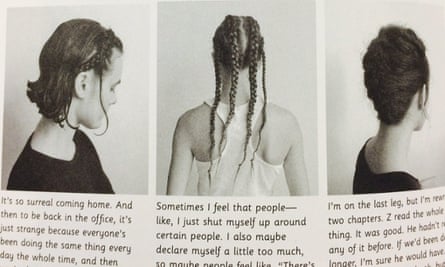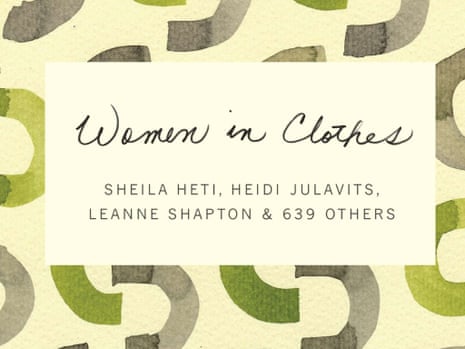“Women in Clothes is a book unlike any other,” so begins the inside flap summary of the new paperback book by Sheila Heti (How Should a Person Be), Heidi Julavits (founding editor of The Believer), Leanne Shapton (Swimming Studies) “and 639 others.”
The summary continues: “It is essentially a conversation among hundreds of women of all nationalities – famous, anonymous, religious, secular … young, old” and so forth – on the subject of clothes. I immediately understand this to mean that a widely diverse range of women is going to discuss how they feel about clothing. Not an altogether terrible idea. I like clothes as much as the next gal.
To accomplish this, the editors composed a survey of questions, ie: “Many people say they want to feel ‘comfortable,’ or they that they admire people who seem ‘confident.’ What do these words really mean to you?” – which are then answered by: “Writers, activists, and artists including Cindy Sherman, Kim Gordon, Kalpona Akter, Sarah Nicole Prickett, Tavi Gevinson, Miranda July, Sasha Grey, Lena Dunham and Molly Ringwald.”
I appear to have misunderstood the meaning of “hundreds of women of all nationalities”.
If you look very hard you will find that there are some women from different nationalities spread throughout the book’s 515 pages, though it is clear that the primary goal of this project is not to highlight the ways in which women from different nationalities, races or ethnicities have arrived at their personal style choices, but rather to indulge a clique-membership mentality in which irony and quirk equals highest regard.
For example, there is an entire section about what women say when they get their hair braided, featuring nine photographs of white women in various stages of hair-braided repose. This might have been a good place to include a woman from a different race – say, a black woman, for whom a relationship with braided hair is deeply intrinsic, and actually interesting. Alas, what we get are carefully curated outtakes presumably from a one-on-one hair-braiding session: “I noticed Y was following me on Twitter, so I followed her back … Then she tweeted about animal rape, and I had been doing this research on duck rape – one third of all duck sex is rape.”

Women in Clothes could have been a thoughtful exploration of elegance and artistry, self-awareness and self-design, but is nothing more than an exercise in narcissism, and a knowing appropriation of that which is pleasing to three middle-class white women, without giving any real emphasis to true individuality.
Inside the bespoke meets definitively twee packaging – with its thick arty paper, casually loopy title script, and mod cover of abstract shapes illustrated by Leanne Shapton – a lengthy table of contents lists various section heads with titles such as “Conversations” (four women talk about their experience at a clothing swap; two women discuss fake eyelashes and 3D lips), “On Dressing” (Sheila Heti answers survey questions with phrases from her diary), and “Collections.” The latter which, although I am happy to see includes the concert T-shirts of my friend Gwen Smith, who is black, otherwise reads much like a white girls’ guide for how to make things you can buy at Urban Outfitters seem covetous. To wit: “Luise Stauss’s over-the-knee-socks,” “Lydia Burkhalter’s gray sweatshirts,” “Delia Marcus’s friendship bracelets,” and “Tift Merritt’s handmade guitar straps.”
The introduction is both banal and stunningly self-important, as correspondence between the three primary editors via Skype and email is transcribed, seemingly unedited, and ostensibly to offer insight into how they came up with the idea for the book:
Sheila: Oh my god, look at your hair!
Leanne: I know. (laughs)…
Heidi: I have no new hair to share, no new hair. Sheila, are you growing your bangs out?
Sheila: Not intentionally.
Leanne: This is how our book should start: Hi, are you growing your bangs out?
Lo and behold, that is in fact how their book starts. But not before Sheila Heti explains the real impetus for the book: “I began living with a man who cares a lot about dressing and clothes. … I began to see that dressing is like everything else: those who dress well do so because they spend some time thinking about it.” But who decides what “dressing well” means or looks like? And what of those who believe, myself included, that thinking about dressing well is the absolute antithesis of style?
There are illustrations and a few photos throughout. Zosia Mamet, dressed in a black full-body leotard and ballet slippers, is featured in a seven-page series of “poses for fashion media”. While fellow Girls star and creator Lena Dunham weighs in with her signature aplomb, whereupon she lays out her dressing rules: “I like to be a character – schoolgirl, new lesbian, lapsed nun, Miami mistress. Not everyone needs that added layer, but it helps me.”
It is not that there aren’t lovely writers and artists featured herein – indeed, I am a fan of, among others, the women from the podcast Black Girls Talking. I also love Kim Gordon, because she’s Kim Gordon, and she’s a genius. Roxane Gay, Rivka Galchen, Abi Slone, Cindy Sherman, Marie Myung-Ok Lee – all women I admire.
I can’t help but think, though, that real style and the very personal clothing choices Women in Clothes dictates is less about descriptions of the mind or knee-sock collections, and more (I don’t want to come across as too precious here), about individual essence, for which there actually are no words.

Comments (…)
Sign in or create your Guardian account to join the discussion